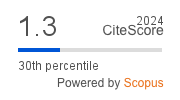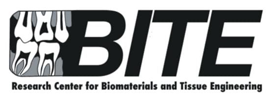Pomegranate-peel-chitosan-gelatin composite: A hemostatic dental sponge with antibacterial enhancement
Downloads
Background: Effective post-tooth extraction bleeding management and the alleviation of patient discomfort hinge upon the careful choice and judicious application of suitable hemostatic agents. Purpose: In this study, we developed a biodegradable, porous hemostatic sponge composed of gelatin (GE) and chitosan (CS), enhanced by the incorporation of pomegranate peel extract (PE), which was designed for use in dental applications, with a focus on antibacterial properties and infection prevention. Methods: The sponge was synthesized using an environmentally friendly (green) foaming approach without a foaming agent and was fabricated by freeze-drying. The efficiency of the hemostatic sponge was evaluated using various tests, including structural analysis, mechanical strength, water absorption capacity, hydrophilicity, blood clotting time (BCT), in vitro antibacterial effectiveness, and biodegradability. Results: The calcium chloride–crosslinked CS-GE and PE-immersed (CS-GE-PE) sponges exhibited adequate tensile strengths, with CS-GE-PE at 0.776 ± 0.025 MPa. The CS-GE-PE sponge showed significant water absorption (927.1% ± 37.55%). Hydrophilicity was evident (contact angle: 45°) and decreased slightly with the addition of PE. The BCT was shorter for the CS-GE sponge (161 ± 9.644 s), and both sponges exhibited minimal hemolysis, indicating biocompatibility. The CS-GE-PE sponge exhibited slightly enhanced antibacterial properties. Conclusion: This study has successfully developed a composite sponge consisting of CS, GE, and PE that exhibits a balanced level of biodegradability, antibacterial and anti-inflammatory properties, and blood absorption properties that reduce clotting time. This innovative material has great potential for a wide range of clinical applications in dental procedures and wound care.
Downloads
Hanafiah OA, Hanafiah DS, Syaflida R. The effect of 3% binahong leaf extract gel on the wound healing process of post tooth extraction. Dent J. 2021; 54(2): 57–62. doi: https://doi.org/10.20473/j.djmkg.v54.i2.p57-62
Caliskan M, Tukel H, Benlidayi E, Deniz A. Is it necessary to alter anticoagulation therapy for tooth extraction in patients taking direct oral anticoagulants? Med Oral Patol Oral y Cir Bucal. 2017; 22(6): e767–73. doi: https://doi.org/10.4317/medoral.21942
Kazancıoğlu HO, Çakır O, Ak G, Zülfikar B. The effectiveness of a new hemostatic agent (ankaferd blood stopper) for the control of bleeding following tooth extraction in hemophilia: A controlled clinical trial. Turkish J Hematol. 2013; 30(1): 19–24. doi: https://doi.org/10.4274/tjh.2012.0036
Abdelaziz M, Shaaban R, Abdelhalim S, Sadaka M. Effect of Collaplug® on the healing of extraction sockets in patients under oral anticoagulant therapy (clinical study). Alexandria Dent J. 2015; 40(2): 166–72. doi: https://doi.org/10.21608/adjalexu.2015.59145
Irfan NI, Mohd Zubir AZ, Suwandi A, Haris MS, Jaswir I, Lestari W. Gelatin-based hemostatic agents for medical and dental application at a glance: A narrative literature review. Saudi Dent J. 2022; 34(8): 699–707. doi: https://doi.org/10.1016/j.sdentj.2022.11.007
Arteagoitia M, Barbier L, Santamaria J, Santamaria G, Ramos E. Efficacy of amoxicillin and amoxicillin/clavulanic acid in the prevention of infection and dry socket after third molar extraction. A systematic review and meta-analysis. Med Oral Patol Oral y Cir Bucal. 2016; 21(4): e494-504. doi: https://doi.org/10.4317/medoral.21139
Shakiba-Marani R, Ehtesabi H. A flexible and hemostatic chitosan, polyvinyl alcohol, carbon dot nanocomposite sponge for wound dressing application. Int J Biol Macromol. 2023; 224: 831–9. doi: https://doi.org/10.1016/j.ijbiomac.2022.10.169
Sun Y, Miao T, Wang Y, Wang X, Lin J, Zhao N, Hu Y, Xu F-J. A natural polyphenol-functionalized chitosan/gelatin sponge for accelerating hemostasis and infected wound healing. Biomater Sci. 2023; 11(7): 2405–18. doi: https://doi.org/10.1039/D2BM02049A
Assinger A, Schrottmaier WC, Salzmann M, Rayes J. Platelets in sepsis: an update on experimental models and clinical data. Front Immunol. 2019; 10: 1687. doi: https://doi.org/10.3389/fimmu.2019.01687
Liu R, Dai L, Si C, Zeng Z. Antibacterial and hemostatic hydrogel via nanocomposite from cellulose nanofibers. Carbohydr Polym. 2018; 195: 63–70. doi: https://doi.org/10.1016/j.carbpol.2018.04.085
Zhang S, Li J, Chen S, Zhang X, Ma J, He J. Oxidized cellulose-based hemostatic materials. Carbohydr Polym. 2020; 230: 115585. doi: https://doi.org/10.1016/j.carbpol.2019.115585
Yang X, Liu W, Li N, Wang M, Liang B, Ullah I, Luis Neve A, Feng Y, Chen H, Shi C. Design and development of polysaccharide hemostatic materials and their hemostatic mechanism. Biomater Sci. 2017; 5(12): 2357–68. doi: https://doi.org/10.1039/C7BM00554G
Liu J-Y, Hu Y, Li L, Wang C, Wang J, Li Y, Chen D, Ding X, Shen C, Xu F-J. Biomass-derived multilayer-structured microparticles for accelerated hemostasis and bone repair. Adv Sci. 2020; 7(22): 2002243. doi: https://doi.org/10.1002/advs.202002243
Liang Y, Li Z, Huang Y, Yu R, Guo B. Dual-dynamic-bond cross-linked antibacterial adhesive hydrogel sealants with on-demand removability for post-wound-closure and infected wound healing. ACS Nano. 2021; 15(4): 7078–93. doi: https://doi.org/10.1021/acsnano.1c00204
Xu Z, Tian W, Wen C, Ji X, Diao H, Hou Y, Fan J, Liu Z, Ji T, Sun F, Wu D, Zhang J. Cellulose-based cryogel microspheres with nanoporous and controllable wrinkled morphologies for rapid hemostasis. Nano Lett. 2022; 22(15): 6350–8. doi: https://doi.org/10.1021/acs.nanolett.2c02144
Takagi T, Tsujimoto H, Torii H, Ozamoto Y, Hagiwara A. Two-layer sheet of gelatin: A new topical hemostatic agent. Asian J Surg. 2018; 41(2): 124–30. doi: https://doi.org/10.1016/j.asjsur.2016.09.007
Herliana H, Yusuf HY, Laviana A, Wandawa G, Cahyanto A. Characterization and analysis of chitosan-gelatin composite-based biomaterial effectivity as local hemostatic agent: A systematic review. Polymers (Basel). 2023; 15(3): 575. doi: https://doi.org/10.3390/polym15030575
Malviya S, Arvind, Jha A, Hettiarachchy N. Antioxidant and antibacterial potential of pomegranate peel extracts. J Food Sci Technol. 2014; 51(12): 4132–7. doi: https://doi.org/10.1007/s13197-013-0956-4
Ferrazzano GF, Scioscia E, Sateriale D, Pastore G, Colicchio R, Pagliuca C, Cantile T, Alcidi B, Coda M, Ingenito A, Scaglione E, Cicatiello AG, Volpe MG, Di Stasio M, Salvatore P, Pagliarulo C. In vitro antibacterial activity of pomegranate juice and peel extracts on cariogenic bacteria. Biomed Res Int. 2017; 2017: 1–7. doi: https://doi.org/10.1155/2017/2152749
Amiruddin, Muh. Agus Syamsur Rijal, Dewi Melani Hariyadi. Effect of CaCl2 crosslinker concentration on the characteristics, release and stability of ciprofloxacin hcl-alginate-carrageenan microspheres. J Farm Ilmu Kefarmasian Indones. 2023; 10(3): 312–23. doi: https://doi.org/10.20473/jfiki.v10i32023.312-323
Doustdar F, Olad A, Ghorbani M. Effect of glutaraldehyde and calcium chloride as different crosslinking agents on the characteristics of chitosan/cellulose nanocrystals scaffold. Int J Biol Macromol. 2022; 208: 912–24. doi: https://doi.org/10.1016/j.ijbiomac.2022.03.193
Rozykulyyeva L, Astuti SD, Zaidan AH, Pradhana AAS, Puspita PS. Antibacterial activities of green synthesized silver nanoparticles from Punica granatum peel extract. In: AIP Conference Proceedings. 2020. p. 060012. doi: https://doi.org/ 10.1063/5.0034126
Sharifi S, Maleki Dizaj S, Ahmadian E, Karimpour A, Maleki A, Memar MY, Ghavimi MA, Dalir Abdolahinia E, Goh KW. A biodegradable flexible micro/nano-structured porous hemostatic dental sponge. Nanomaterials. 2022; 12(19): 3436. doi: https://doi.org/10.3390/nano12193436
Nasruddin, Susanto T. Composites of natural rubber, carbon black, and kaolin sodium bicarbonate content for sponge application. IOP Conf Ser Mater Sci Eng. 2019; 509(1): 012094. doi: https://doi.org/10.1088/1757-899X/509/1/012094
Pan S, Li Y, Tong X, Chen L, Wang L, Li T, Zhang Q. Strongly-adhesive easily-detachable carboxymethyl cellulose aerogel for noncompressible hemorrhage control. Carbohydr Polym. 2023; 301: 120324. doi: https://doi.org/10.1016/j.carbpol.2022.120324
Cai B, Zhong T, Chen P, Fu J, Jin Y, Liu Y, Huang R, Tan L. Preparation, characterization and in vitro release study of drug-loaded sodium carboxy-methylcellulose/chitosan composite sponge. Mishra YK, editor. PLoS One. 2018; 13(10): e0206275. doi: https://doi.org/10.1371/journal.pone.0206275
Jahan N, Ibne Mahbub MS, Lee B-T, Bae SH. In Vivo and In Vitro Investigation of a Novel Gelatin/Sodium Polyacrylate Composite Hemostatic Sponge for Topical Bleeding. J Funct Biomater. 2023; 14(5): 265. doi: https://doi.org/10.3390/jfb14050265
Wang J, Chen Y, Xu Q, Cai M, Shi Q, Gao J. Highly efficient reusable superhydrophobic sponge prepared by a facile, simple and cost effective biomimetic bonding method for oil absorption. Sci Rep. 2021; 11(1): 11960. doi: https://doi.org/10.1038/s41598-021-91396-9
Singh S, Nwabor OF, Sukri DM, Wunnoo S, Dumjun K, Lethongkam S, Kusolphat P, Hemtanon N, Klinprathum K, Sunghan J, Dejyong K, Lertwittayanon K, Pisuchpen S, Voravuthikunchai SP. Poly (vinyl alcohol) copolymerized with xanthan gum/hypromellose/sodium carboxymethyl cellulose dermal dressings functionalized with biogenic nanostructured materials for antibacterial and wound healing application. Int J Biol Macromol. 2022; 216: 235–50. doi: https://doi.org/10.1016/j.ijbiomac.2022.06.172
Behrens AM, Sikorski MJ, Li T, Wu ZJ, Griffith BP, Kofinas P. Blood-aggregating hydrogel particles for use as a hemostatic agent. Acta Biomater. 2014; 10(2): 701–8. doi: https://doi.org/10.1016/j.actbio.2013.10.029
Zhao Y-F, Zhao J-Y, Hu W-Z, Ma K, Chao Y, Sun P-J, Fu X-B, Zhang H. Synthetic poly(vinyl alcohol)–chitosan as a new type of highly efficient hemostatic sponge with blood-triggered swelling and high biocompatibility. J Mater Chem B. 2019; 7(11): 1855–66. doi: https://doi.org/10.1039/C8TB03181A
Wang Y, Zhou P, Xiao D, Zhu Y, Zhong Y, Zhang J, Sui X, Feng X, Xu H, Mao Z. Chitosan-bound carboxymethylated cotton fabric and its application as wound dressing. Carbohydr Polym. 2019; 221: 202–8. doi: https://doi.org/10.1016/j.carbpol.2019.05.082
Kayabolen A, Keskin D, Aykan A, Karslıoglu Y, Zor F, Tezcaner A. Native extracellular matrix/fibroin hydrogels for adipose tissue engineering with enhanced vascularization. Biomed Mater. 2017; 12(3): 035007. doi: https://doi.org/10.1088/1748-605X/aa6a63
Wang Y, Zhao Y, Qiao L, Zou F, Xie Y, Zheng Y, Chao Y, Yang Y, He W, Yang S. Cellulose fibers-reinforced self-expanding porous composite with multiple hemostatic efficacy and shape adaptability for uncontrollable massive hemorrhage treatment. Bioact Mater. 2021; 6(7): 2089–104. doi: https://doi.org/10.1016/j.bioactmat.2020.12.014
Fang H, Li D, Xu L, Wang Y, Fei X, Tian J, Li Y. A reusable ionic liquid-grafted antibacterial cotton gauze wound dressing. J Mater Sci. 2021; 56(12): 7598–612. doi: https://doi.org/10.1007/s10853-020-05751-8
Monfared-Hajishirkiaee R, Ehtesabi H, Najafinobar S, Masoumian Z. Multifunctional chitosan/carbon dots/sodium alginate/zinc oxide double-layer sponge hydrogel with high antibacterial, mechanical and hemostatic properties. OpenNano. 2023; 12: 100162. doi: https://doi.org/10.1016/j.onano.2023.100162
Ramasubramaniam S, Govindarajan C, Nasreen K, Sudha PN. Removal of cadmium (II) ions from aqueous solution using chitosan/starch polymer blend. Compos Interfaces. 2014; 21(2): 95–109. doi: https://doi.org/10.1080/15685543.2013.834199
Haider A, Waseem A, Karpukhina N, Mohsin S. Strontium- and zinc-containing bioactive glass and alginates scaffolds. Bioengineering. 2020; 7(1): 10. doi: https://doi.org/10.3390/bioengineering7010010
Kimi M, Chong CJ. Facile preparation of chitosan-alginate crosslinked with calcium chloride hydrogel as sustained release fertilizers. 2024. p. 1–24. doi: https://doi.org/10.21203/rs.3.rs-3855172/v1
Hao Y, Zhao W, Zhang L, Zeng X, Sun Z, Zhang D, Shen P, Li Z, Han Y, Li P, Zhou Q. Bio-multifunctional alginate/chitosan/fucoidan sponges with enhanced angiogenesis and hair follicle regeneration for promoting full-thickness wound healing. Mater Des. 2020; 193: 108863. doi: https://doi.org/10.1016/j.matdes.2020.108863
Mahmoudi A, Ghavimi MA, Maleki Dizaj S, Sharifi S, Sajjadi SS, Jamei Khosroshahi AR. Efficacy of a new hemostatic dental sponge in controlling bleeding, pain, and dry socket following mandibular posterior teeth extraction—A split-mouth randomized double-blind clinical trial. J Clin Med. 2023; 12(14): 4578. doi: https://doi.org/10.3390/jcm12144578
Zhang Y, Guan J, Wu J, Ding S, Yang J, Zhang J, Dong A, Deng L. N-alkylated chitosan/graphene oxide porous sponge for rapid and effective hemostasis in emergency situations. Carbohydr Polym. 2019; 219: 405–13. doi: https://doi.org/10.1016/j.carbpol.2019.05.028
Su C, Zhao H, Yang H, Chen R. Stearic acid-modified starch/chitosan composite sponge with asymmetric and gradient wettability for wound dressing. ACS Appl Bio Mater. 2019; 2(1): 171–81. doi: https://doi.org/10.1021/acsabm.8b00508
Bal‐Ozturk A, Karal‐Yilmaz O, Akguner ZP, Aksu S, Tas A, Olmez H. Sponge‐like chitosan‐based nanostructured antibacterial material as a topical hemostat. J Appl Polym Sci. 2019; 136(19). doi: https://doi.org/10.1002/app.47522
Cao S, Bi Z, Li Q, Zhang S, Singh M, Chen J. Shape memory and antibacterial chitosan-based cryogel with hemostasis and skin wound repair. Carbohydr Polym. 2023; 305: 120545. doi: https://doi.org/10.1016/j.carbpol.2023.120545
Xia Y, Yang R, Wang H, Li Y, Fu C. Application of chitosan-based materials in surgical or postoperative hemostasis. Front Mater. 2022; 9(994265). doi: https://doi.org/10.3389/fmats.2022.994265
Xie X, Li D, Chen Y, Shen Y, Yu F, Wang W, Yuan Z, Morsi Y, Wu J, Mo X. Conjugate electrospun 3D gelatin nanofiber sponge for rapid hemostasis. Adv Healthc Mater. 2021; 10(20): 2100918. doi: https://doi.org/10.1002/adhm.202100918
Zhang Y, Wang Y, Chen L, Zheng J, Fan X, Xu X, Zhou G, Ullah N, Feng X. An injectable antibacterial chitosan-based cryogel with high absorbency and rapid shape recovery for noncompressible hemorrhage and wound healing. Biomaterials. 2022; 285: 121546. doi: https://doi.org/10.1016/j.biomaterials.2022.121546
Copyright (c) 2025 Dental Journal

This work is licensed under a Creative Commons Attribution-ShareAlike 4.0 International License.
- Every manuscript submitted to must observe the policy and terms set by the Dental Journal (Majalah Kedokteran Gigi).
- Publication rights to manuscript content published by the Dental Journal (Majalah Kedokteran Gigi) is owned by the journal with the consent and approval of the author(s) concerned.
- Full texts of electronically published manuscripts can be accessed free of charge and used according to the license shown below.
- The Dental Journal (Majalah Kedokteran Gigi) is licensed under a Creative Commons Attribution-ShareAlike 4.0 International License

















